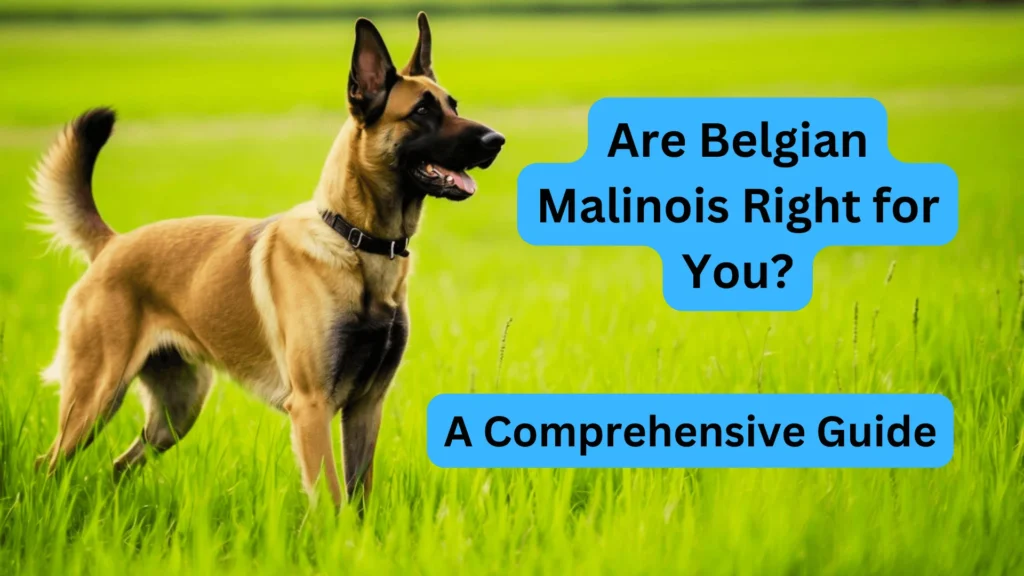
Introduction
Brief Overview of the Belgian Malinois Breed
The Belgian Malinois is a medium-sized herding dog that is part of the Belgian Shepherd family, which also includes the Tervuren, Laekenois, and Groenendael. Known for its athletic build, sharp mind, and boundless energy, the Malinois has a striking appearance. With a sleek, short coat typically fawn-colored with a black mask, the breed exudes confidence and alertness.
Malinois are revered for their working ability and are commonly seen in roles that require focus, agility, and stamina. From police and military service to search-and-rescue operations, their adaptability is unmatched. Despite their intense working demeanor, they can also be loving companions when raised in a nurturing and structured environment.
Why They Are Popular?
The Belgian Malinois has gained immense popularity due to its extraordinary traits. Known for their intelligence, they excel in advanced training and can quickly master complex tasks and commands, making them ideal for specialized roles such as bomb detection and therapy work. Their loyalty is another defining characteristic, as Malinois form deep bonds with their handlers and families. They are constantly alert and prepared to protect their loved ones because of their protective nature.
Additionally, their versatility shines through in various settings, whether it’s herding livestock, participating in agility competitions, or serving in law enforcement. With their high energy and drive, Malinois are well-suited for both professional roles and active household environments. These exceptional qualities have made them a go-to breed for a wide range of jobs, from military K9 units to family homes that prioritize activity and engagement.
History and Origin
Roots in Belgium as a Herding Breed
The late 19th century saw the emergence of the Belgian Malinois in Belgium’s agricultural areas.As a herding breed, they were bred to manage livestock with precision and efficiency. Farmers relied on their agility, sharp instincts, and relentless drive to control sheep and cattle.
Their herding abilities set them apart from other breeds, as they combined speed with an inherent ability to anticipate the movements of livestock, making them indispensable on Belgian farms.
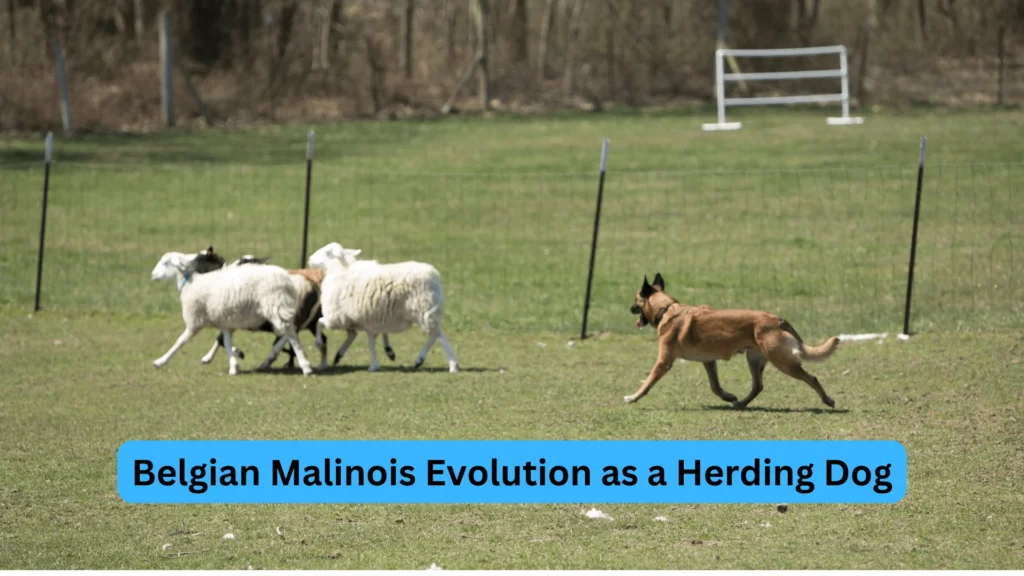
Named After the Belgian City of Malines
The breed gets its name from the city of Malines (Mechelen in Flemish), located in northern Belgium. Malines was a hub for farmers and herding enthusiasts who meticulously developed and refined the breed. The city played a pivotal role in the standardization of the Belgian Malinois, ensuring the breed retained its distinctive traits of agility, focus, and diligence.
Evolution from a Herding Dog to a Multifaceted Working Breed
While the Belgian Malinois began its journey as a herding dog, its capabilities quickly gained recognition in other areas. By the early 20th century, their potential for police and military work became evident. Their intelligence, coupled with their ability to stay calm under pressure, made them ideal for roles beyond the pasture.
- Military and Police Work
- During World War I and II, Belgian Malinois were employed as messenger dogs, ambulance dogs, and even in tracking missions.
- Today, they are a staple in police forces worldwide, excelling in tasks like drug detection, search-and-rescue operations, and suspect apprehension.
- Search and Rescue
- Their keen sense of smell and high energy levels make them indispensable in disaster response scenarios.
- They have been part of missions in earthquake zones, avalanches, and other emergencies.
- Sports and Competitions
- The Malinois thrives in dog sports like agility, obedience trials, and schutzhund (protection work).
- Their athleticism and eagerness to please make them natural competitors.
From humble beginnings as a farm helper in Belgium to serving as a trusted partner in life-saving operations worldwide, the Belgian Malinois has evolved into one of the most versatile and admired breeds. Its versatility and steadfast work ethic are demonstrated by its history.
Physical Characteristics
Size and Build
It is commonly known that the medium-sized Belgian Malinois has a muscular, well-proportioned body. Its physical structure is designed for endurance, speed, and agility, making it an ideal breed for high-energy and demanding activities.
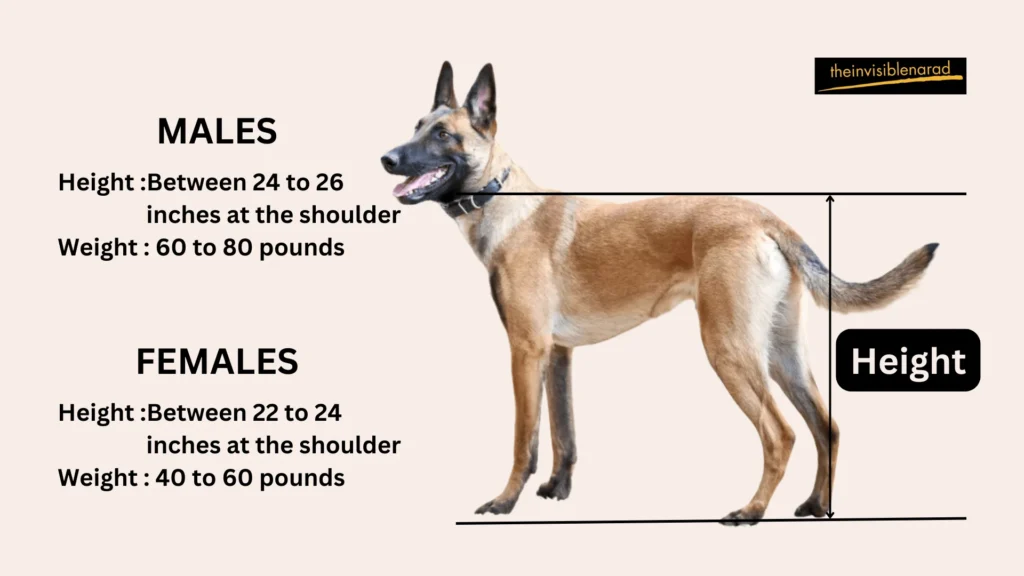
- Height and Weight
- Males typically stand between 24 to 26 inches at the shoulder and weigh 60 to 80 pounds.
- Females are slightly smaller, ranging from 22 to 24 inches in height and weighing 40 to 60 pounds.
- Muscular Yet Agile
- Their lean musculature ensures they remain agile and swift, whether herding livestock or chasing down suspects in law enforcement tasks.
- Despite their muscular frame, they retain a light-footed grace, capable of quick, precise movements.
- Proportional Body Structure
- The Malinois exhibits a balanced body with a slightly elongated torso, a deep chest for optimal lung capacity, and a tucked-up abdomen, all contributing to their stamina and speed.
This combination of strength and agility allows the Belgian Malinois to excel in various physically demanding roles, from search-and-rescue missions to competitive dog sports.
Coat and Color
One of the most striking features of the Belgian Malinois is its short, weather-resistant coat, which requires minimal maintenance yet offers excellent protection.
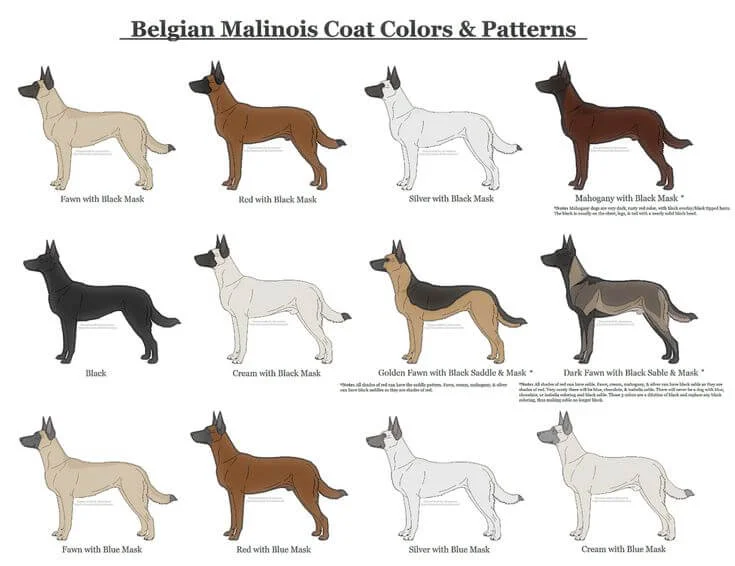
- Coat Texture
- A short, straight, and silky outer coat and a thick, water-resistant undercoat make up the Malinois’ double coat.
- This coat provides them with insulation in colder climates while being breathable enough for warmer conditions.
- Color Patterns
- The most common coat colors are fawn and mahogany, with variations in shade that range from light beige to deep reddish-brown.
- A distinguishing feature is the black mask that covers their muzzle, extending up to their eyes, giving them a regal and intense expression.
- The tips of their ears and tail may also display darker shading, adding contrast to their overall appearance.
- Low Maintenance
- Their coat is relatively easy to care for, requiring weekly brushing to remove loose hair and occasional baths to keep it clean and shiny.
The Belgian Malinois’ coat not only enhances their appearance but also serves a functional purpose, helping them adapt to different climates and environments.
Distinctive Features
The Belgian Malinois is instantly recognizable due to its distinct and commanding appearance.
- Erect Ears
- One of their most defining physical traits is their upright, triangular-shaped ears, which are set high on the head.
- The breed’s keen and perceptive character is reflected in these ears, which are constantly on guard.
- Expressive Eyes
- Their almond-shaped eyes are typically dark brown and exude intelligence, focus, and a hint of curiosity.
- The intensity of their gaze often gives an impression of them being deep thinkers.
- Confident Stance
- The Malinois carries itself with a natural poise and confidence.
- Their straight back, proud head carriage, and steady, purposeful gait signal their readiness to act.
- Whether at rest or in motion, they exhibit an air of alertness, always prepared to respond to their environment.
These features make the Belgian Malinois not only a physically striking dog but also one that commands respect and admiration wherever they go.
Temperament and Personality
Highly Intelligent and Alert
The Belgian Malinois is often celebrated as one of the most intelligent dog breeds in the world. Their sharp minds make them quick learners, capable of understanding and executing even the most complex commands.
- Problem-Solving Skills
- They excel in tasks requiring critical thinking, such as search-and-rescue operations and competitive dog sports.
- Their problem-solving abilities allow them to adapt quickly to new challenges, making them highly versatile.
- Keen Observation
- Malinois are incredibly perceptive and observant of their environment.
- Their acute senses and ability to read subtle cues make them invaluable in roles like law enforcement, where vigilance is paramount.
This intelligence and alertness demand an owner who can provide structured training and engage them in mentally stimulating activities to keep them satisfied and well-behaved.
Naturally Protective and Loyal to Family
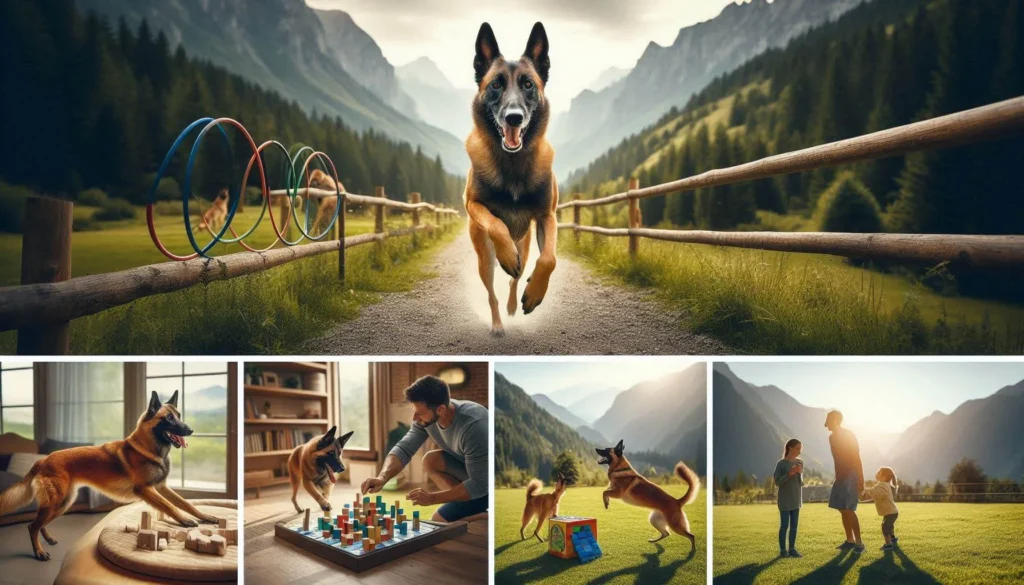
The Belgian Malinois’s innate protective instincts and strong loyalty are among its most distinctive characteristics.
- Guardian Instincts
- Malinois have an innate drive to protect their loved ones, making them excellent watchdogs and guardians.
- Their protective nature, however, is measured and calculated, rarely acting out unless they perceive a genuine threat.
- Family Bonding
- They form strong emotional bonds with their family members, often choosing a “favorite” person to whom they are exceptionally devoted.
- This loyalty is coupled with a desire to please, which makes training more effective when approached positively.
While their protective instincts make them an excellent choice for families, it’s crucial to socialize them early to ensure they can differentiate between real threats and everyday interactions.
Energetic and Requires Mental and Physical Stimulation
The Belgian Malinois is a high-energy breed that thrives on activity and purpose. Their drive to work and play is unmatched, making them best suited for owners who lead active lifestyles.
- Physical Energy
- Malinois require regular, rigorous exercise, including long walks, runs, or agility training, to stay physically fit.
- A lack of physical stimulation can lead to boredom, which may manifest as destructive behaviors like chewing or excessive barking.
- Mental Engagement
- Just as important as physical activity is mental stimulation. They take pleasure in intellectually demanding activities, obedience training, and games that require them to solve problems.
- Activities like nose work, puzzle toys, or advanced training drills can keep their minds sharp and their behavior balanced.
Owners must be prepared to dedicate time to meet these needs, as a sedentary or unstimulated Malinois may become frustrated and difficult to manage.
Social and Affectionate but Reserved with Strangers
The Belgian Malinois strikes a balance between being a loving companion to its family and maintaining a cautious demeanor around unfamiliar people.
- Affectionate at Home
- They are known for their affectionate nature with their families, often seeking physical closeness and thriving on positive interactions.
- Malinois enjoy being part of family activities and will actively seek out attention and companionship.
- Reserved with Strangers
- While not aggressive, they are naturally reserved and watchful around strangers.
- This trait stems from their protective instincts and high level of discernment, which makes them excellent at assessing unfamiliar situations.
Early socialization is key to helping them develop a balanced approach to meeting new people and navigating different environments.
Belgian Malinois as a Working Dog
Police and Military Roles

The Belgian Malinois is a top choice for police and military forces worldwide, thanks to its sharp instincts, trainability, and unrelenting work ethic.
- Detection
- Malinois are widely used for detecting explosives, narcotics, and other contraband.
- Their keen sense of smell, coupled with rigorous training, enables them to identify even the faintest scents with remarkable accuracy.
- In high-stakes environments, their efficiency in detection tasks has saved countless lives.
- Tracking
- These dogs excel in tracking individuals over vast distances and varied terrains.
- Whether pursuing a fleeing suspect or locating missing persons, their ability to follow a scent trail is unparalleled.
- Their stamina allows them to maintain focus over extended periods, crucial in time-sensitive operations.
- Apprehension
- Malinois are known for their controlled aggression and courage when apprehending suspects.
- They can be trained to immobilize a target without causing undue harm, a skill critical in law enforcement scenarios.
- Their speed and agility make them effective in dynamic, fast-paced situations.
These qualities have led to their deployment in elite military units, such as the U.S. Navy SEALs, where they perform tasks ranging from tactical reconnaissance to parachute missions.
Search and Rescue
The Belgian Malinois are perfect for search and rescue (SAR) missions because of their keen senses, intellect, and work ethic.
- Unmatched Scenting Abilities
- With a sense of smell significantly more sensitive than that of humans, Malinois are able to detect scents buried under rubble, snow, or water.
- They can differentiate between various odors, enabling them to locate specific individuals in challenging environments.
- Adaptability in Diverse Environments
- Whether working in urban disaster zones, dense forests, or mountainous regions, their agility and stamina allow them to perform effectively.
- Their calm demeanor in chaotic situations ensures they remain focused, even in stressful conditions.
- Quick Learners
- Their intelligence and eagerness to work make them fast learners, able to master complex SAR protocols.
- They work well as part of a team, responding swiftly to commands and adapting to evolving situations.
The Malinois’ dedication and skill in search and rescue operations have made them invaluable in disasters, including earthquakes, floods, and missing person searches.
Sports and Competitions
In addition to their working roles, Belgian Malinois are stars in various canine sports and competitions, showcasing their physical and mental capabilities.
- Agility
- Their speed, flexibility, and quick reflexes make them top performers in agility competitions.
- Navigating obstacle courses with precision and speed, they consistently earn top rankings.
- Obedience
- Obedience trials highlight their ability to follow commands accurately and efficiently.
- Malinois’ eagerness to please and bond with their handlers ensures they excel in these events.
- Schutzhund
- Originating in Germany, Schutzhund tests a dog’s tracking, obedience, and protection skills.
- The Malinois is a standout in this sport, demonstrating its prowess in all three areas.
- Their drive and focus make them a popular breed among Schutzhund enthusiasts, where they compete against the best working dogs worldwide.
In addition to giving Malinois cerebral and physical stimulation, sports and competitions help to deepen the link between the dog and its handler.
Training and Socialization
Training and socialization are critical for ensuring the Belgian Malinois develops into a well-rounded, obedient, and confident dog. Due to their intelligence, energy, and protective instincts, early and consistent training is non-negotiable for this breed. A well-socialized and trained Malinois can thrive as both a working dog and a family companion.
Training Needs: Importance of Consistent and Positive Reinforcement
Belgian Malinois are highly trainable, but their intelligence and energy levels require structured, ongoing training.
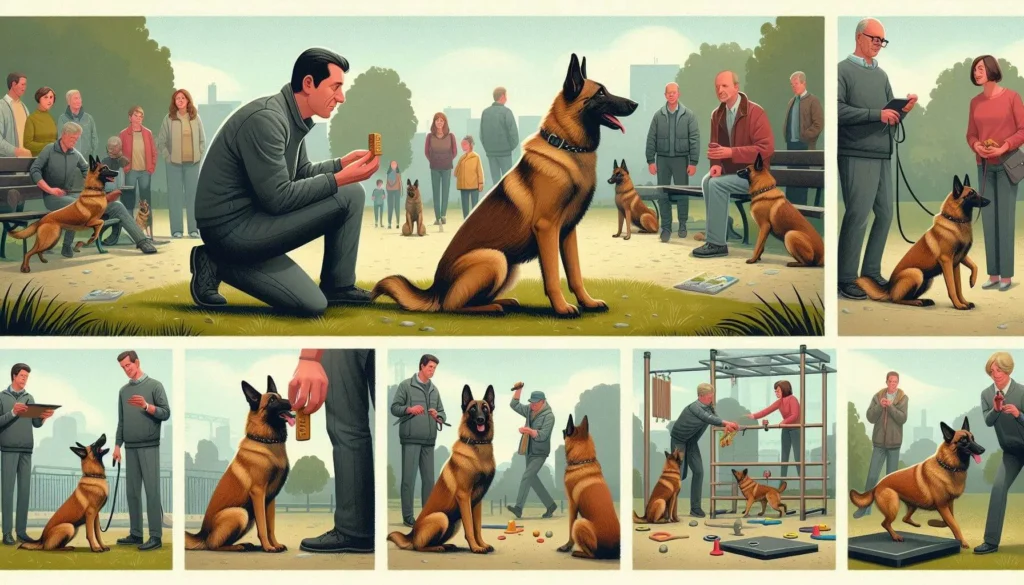
- Consistency is Key
- Malinois respond best to clear, consistent commands and a well-established routine.
- Inconsistent or lenient training can lead to confusion and behavioral issues, as these dogs thrive on structure.
- Positive Reinforcement
- Reward-based methods, such as treats, praise, or playtime, are particularly effective for this breed.
- Avoid harsh or punitive techniques, as they can lead to fear or anxiety, negatively impacting the dog’s behavior.
- Early Start
- Beginning training in puppyhood ensures that the dog learns good habits early, preventing unwanted behaviors from becoming ingrained.
- Early lessons should include basic commands like sit, stay, and recall.
A Belgian Malinois trained with patience and positivity will be a responsive, reliable, and eager-to-please companion.
Socialization: Early Exposure to People, Environments, and Animals
Socialization is essential for the Belgian Malinois to develop balanced behavior and prevent excessive wariness or aggression.
- Early Exposure
- Introduce puppies to a variety of people, environments, and situations from an early age.
- Being exposed to a variety of sights, sounds, and textures enables children to confidently adjust to new situations.
- Interaction with Other Animals
- Gradual and supervised interactions with other dogs and animals are crucial for fostering sociable behavior.
- This reduces the likelihood of aggressive tendencies or excessive prey drive toward smaller animals.
- Preventing Over-Protectiveness
- While their protective instincts are natural, proper socialization ensures that they can differentiate between genuine threats and everyday encounters.
- Regular visits to parks, busy streets, and gatherings help them feel comfortable around strangers and reduce unnecessary guarding behaviors.
Advanced Obedience and Specialized Training Potential
Due to their intelligence and eagerness to work, Belgian Malinois excel in advanced obedience and specialized training.
- Advanced Obedience
- Beyond basic commands, Malinois can master complex instructions, making them suitable for competitive obedience trials.
- Their ability to focus and follow intricate sequences highlights their advanced learning potential.
- Specialized Training
- With their strong drive and work ethic, Malinois are ideal candidates for roles in police work, search and rescue, and service dog training.
- They can be trained to perform specialized tasks, such as scent detection, tracking, and even assisting individuals with disabilities.
Investing in advanced training enhances the relationship between the handler and the Malinois while also maximizing the dog’s capabilities.
Exercise and Activity Requirements
The Belgian Malinois is a high-energy breed that enjoys mental and physical stimulation. Without adequate exercise and stimulation, they can become restless, frustrated, and destructive. An active lifestyle is essential to keep this breed healthy and happy.
High Energy Level
The Belgian Malinois requires daily exercise to meet its high energy needs.

- Daily Physical Exercise
- A minimum of 60-90 minutes of vigorous exercise is recommended each day.
- Activities such as jogging, long walks, and hiking are ideal for burning off excess energy.
- Agility Training
- Malinois excel in agility sports, which challenge both their physical and mental capabilities.
- Courses with jumps, tunnels, and weave poles are not only fun but also help improve coordination and focus.
- Playtime
- Engaging in games like fetch or frisbee allows them to expend energy while strengthening their bond with their owner.
Regular physical activity is essential to keep the Malinois’ body fit and mind sharp.
Mental Stimulation Through Puzzles and Interactive Games
In addition to physical exercise, mental engagement is crucial for the Belgian Malinois.
- Puzzle Toys
- Interactive toys and puzzles that dispense treats or require problem-solving help keep their minds occupied.
- These activities also reduce boredom and the likelihood of destructive behavior.
- Training Drills
- Regular training sessions, even for already-mastered commands, provide mental stimulation and reinforce discipline.
- Learning new tricks or tasks satisfies their love for challenges and problem-solving.
- Nose Work Games
- Scent-based games, such as hiding treats for the dog to find, cater to their excellent sense of smell while providing mental stimulation.
A balance of physical and mental activities ensures a content and well-behaved Malinois.
Suitability for Active Families or Individuals
The Belgian Malinois thrives in households that can match their energy and dedication.
- Best Fit
- Ideal for active families or individuals who enjoy outdoor activities like running, hiking, or camping.
- Their stamina and eagerness make them excellent companions for athletic lifestyles.
- Children and Other Pets
- With proper training and socialization, Malinois can do well in families with children or other pets.
- However, their high energy levels require supervision to ensure safe and appropriate interactions.
- Not for Sedentary Lifestyles
- This breed is not suited for a low-activity household.
- Owners must commit to meeting their physical and mental needs to prevent behavioral issues.
The Belgian Malinois is a breed that thrives with proper training, early socialization, and an active lifestyle. Their intelligence, versatility, and high energy levels require dedicated owners who can provide consistent guidance, mental stimulation, and ample physical activity. For those who rise to the challenge, the Belgian Malinois proves to be an exceptionally loyal and rewarding companion.
Health and Lifespan
Although the Belgian Malinois is a generally healthy breed, it is susceptible to certain health problems, just like any other dog. Understanding their health requirements and ensuring proper care is crucial to maximize their lifespan and quality of life.
Common Health Issues
While Belgian Malinois are robust and athletic, they can face certain hereditary and lifestyle-related health conditions:
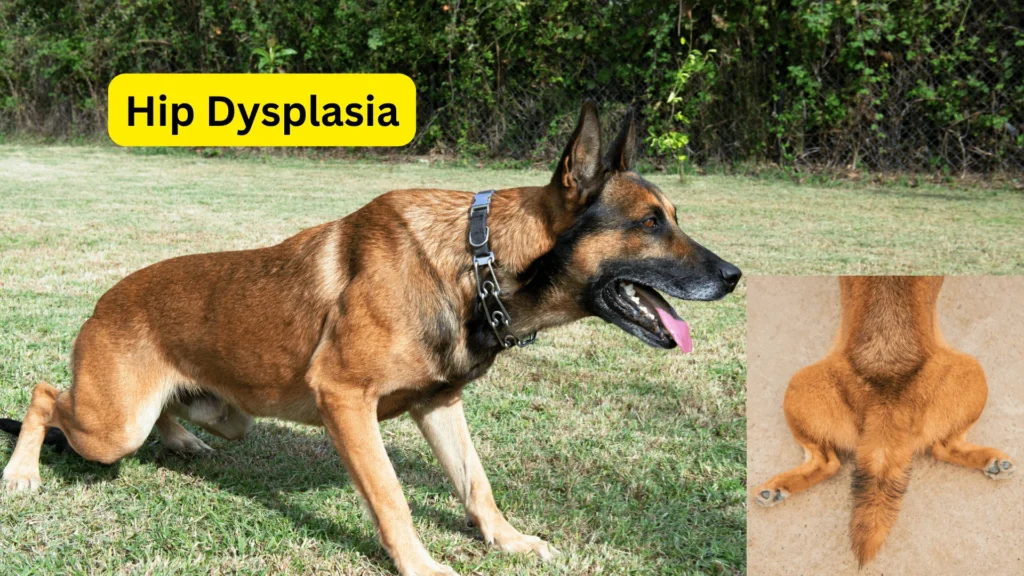
- Hip Dysplasia
- A genetic condition where the hip joint doesn’t fit properly into the hip socket.
- Symptoms include difficulty in movement, pain, and lameness.
- Preventative measures include maintaining a healthy weight and providing joint supplements if necessary.
- Progressive Retinal Atrophy (PRA)
- A degenerative eye disorder that eventually leads to blindness.
- Regular eye exams can aid in early detection and condition management.
- Allergies
- Malinois can develop skin allergies or sensitivities to certain foods or environmental factors.
- Symptoms include excessive scratching, redness, or gastrointestinal issues.
- Proper diagnosis and management through diet changes or medication are essential.
- Other Conditions
- They may also be susceptible to epilepsy, thyroid issues, and bloat (gastric torsion). Early detection and treatment depend on routine health monitoring.
Lifespan: 12-14 Years with Proper Care
With a well-balanced diet, exercise, and preventive healthcare, Belgian Malinois typically live 12 to 14 years.
- Genetics and Care
- A well-bred Malinois from reputable breeders tends to have fewer health concerns.
- Owners should prioritize care routines to enhance longevity and well-being.
- Lifestyle Factors
- Adequate exercise and mental stimulation reduce the risk of obesity and related health problems.
- Stress-free environments and proper socialization contribute to emotional and physical health.
Importance of Regular Vet Check-Ups and a Balanced Diet
Proactive health care is essential to keep your Belgian Malinois in peak condition.
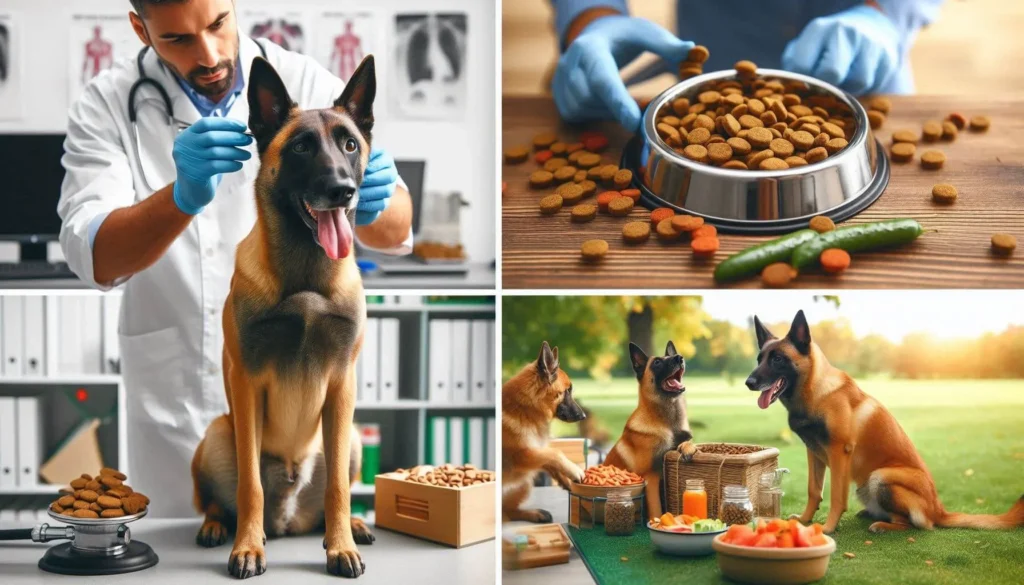
- Vet Check-Ups
- Routine vet visits help catch potential health problems early.
- Annual vaccinations, dental cleaning, and screenings for common conditions are vital.
- Balanced Diet
- A diet rich in high-quality proteins, healthy fats, and essential nutrients supports their active lifestyle.
- Consult a vet for portion control and nutritional recommendations, considering their age, activity level, and health status.
By addressing these health needs, owners can ensure their Malinois lives a long and healthy life.
Belgian Malinois as a Family Dog
The Belgian Malinois can make an excellent family dog for the right household. They are loyal, energetic, and protective, but their specific needs must align with the family’s lifestyle.
Pros of Owning a Malinois
Belgian Malinois offer several advantages as a family pet:
- Companionship
- They are affectionate and bond closely with their family, making them excellent companions.
- Their loyalty ensures a strong emotional connection with their owners.
- Protection
- Natural protectiveness makes them reliable guard dogs, always alert and watchful.
- Their intelligence allows them to distinguish between genuine threats and harmless interactions.
- Playfulness
- Their high energy and enthusiasm make them ideal playmates for active children and adults.
- Engaging them in games like fetch or agility exercises strengthens family bonds.
Challenges: Not Suitable for Sedentary or Inexperienced Owners
Despite their strengths, owning a Malinois comes with challenges:
- High Energy Levels
- Malinois require significant physical and mental stimulation daily. Families with a sedentary lifestyle may struggle to meet these demands.
- Experience Required
- Their intelligence and assertiveness can be overwhelming for inexperienced dog owners.
- Without proper training and socialization, they can become unruly or overly protective.
- Potential for Destructive Behavior
- Boredom or insufficient exercise often leads to destructive behaviors, such as chewing furniture or digging.
Tips for Integrating into Family Life
For families ready to meet the breed’s needs, the following tips can help with a smooth integration:
- Establish a Routine
- Create a daily schedule for feeding, exercise, training, and downtime to give the dog a sense of structure.
- Involve the Whole Family
- Teach all family members how to interact with the dog respectfully and consistently.
- Assign age-appropriate responsibilities, such as feeding or light grooming.
- Supervise Interactions with Children
- Always monitor playtime between the dog and young children to prevent accidental rough play.
- Invest in Training
- Enroll in professional obedience classes to ensure proper behavior and socialization.
- Advanced training can further enhance their role as a family companion or protector.
- Provide Enrichment
- Incorporate puzzle toys, agility courses, and regular outdoor adventures to keep them mentally and physically stimulated.
By understanding their needs and characteristics, families can create a nurturing environment where a Belgian Malinois can thrive as a loyal and cherished family member.
Tips for Potential Owners
Adopting or purchasing a Belgian Malinois requires thoughtful preparation. As intelligent and high-energy dogs, they thrive in environments that cater to their physical, mental, and emotional needs. Prospective owners should ensure they’re well-prepared before bringing a Malinois into their lives.
Researching Reputable Breeders or Adoption Centers
Finding a healthy, well-adjusted Belgian Malinois starts with sourcing them responsibly.

- Reputable Breeders
- Look for breeders who prioritize health, temperament, and responsible breeding practices.
- Ask for health clearances, including tests for hip dysplasia and eye conditions.
- Visit the breeder’s facility to observe the living conditions and meet the puppy’s parents.
- Adoption Centers and Rescues
- Many Belgian Malinois end up in shelters due to their demanding nature. Consider adopting from a reputable rescue organization.
- Ask about the dog’s history, temperament, and any behavioral or medical concerns.
- Be prepared to invest time in rehabilitating and training a rescue dog.
- Red Flags to Avoid
- Avoid breeders who cannot provide health records, force early separation from the mother, or breed excessively for profit.
- Be wary of online sellers with no verifiable credentials or transparency.
Understanding the Commitment Required
Belgian Malinois ownership is not for everyone. Understanding the time, effort, and resources they require is crucial.
- Time Commitment
- Daily exercise, training sessions, and socialization activities are non-negotiable.
- Owners should be able to dedicate at least 1-2 hours a day to physical and mental stimulation.
- Financial Investment
- Costs include high-quality food, routine veterinary care, training classes, and grooming supplies.
- Emergency healthcare and advanced training programs can add to the expenses.
- Lifestyle Compatibility
- Ideal for active individuals or families who enjoy outdoor activities and have a structured lifestyle.
- Not suited for sedentary lifestyles or owners who cannot consistently meet their needs.
Providing a Structured Environment and Plenty of Attention
Belgian Malinois thrive in environments with clear rules, routine, and engagement.
- Structured Environment
- Establish house rules and stick to them consistently.
- Crate training and boundaries can help manage behavior, especially during the early stages.
- Mental and Physical Engagement
- Regular training, interactive toys, and puzzle games keep their intelligent minds stimulated.
- Engage them in physical activities like running, hiking, or agility sports.
- Social Interaction
- They form strong bonds with their families and require consistent attention and companionship.
- Long periods of isolation can lead to anxiety and destructive behaviors.
Conclusion & FAQs
The Belgian Malinois is an exceptional breed, renowned for its intelligence, loyalty, and remarkable versatility. Whether serving as a dedicated working dog in specialized roles such as police, military, or search-and-rescue operations, or as a beloved family companion, the Malinois consistently demonstrates its value and adaptability. Their intelligence and trainability, combined with their innate loyalty and protective nature, make them a standout choice for those seeking a dependable and energetic companion. With proper care, they thrive in roles that demand agility, stamina, and obedience.
However, owning a Belgian Malinois comes with significant responsibilities. Potential owners must fully understand and commit to meeting their high energy levels, mental stimulation requirements, and need for consistent training and socialization. Providing a structured, nurturing environment is essential for them to flourish. While they offer unparalleled companionship and joy, they are best suited to owners who are prepared for their demanding needs and active nature. For those ready to embrace this challenge, the rewards are immense, as the Malinois brings unmatched loyalty, protection, and dynamic energy to any household. Prospective owners are encouraged to learn more through reputable breeders, adoption centers, and breed-specific communities to ensure a successful and fulfilling relationship with this extraordinary dog.
Frequently Asked Questions (FAQs)
Are Belgian Malinois good family dogs?
Yes, Belgian Malinois can be excellent family dogs when properly trained and socialized. They are loyal, protective, and affectionate.
How much exercise does a Belgian Malinois need daily?
Belgian Malinois require at least 1-2 hours of physical activity and mental stimulation daily to remain healthy and happy.
Are Belgian Malinois aggressive?
Belgian Malinois are not inherently aggressive but can be protective. Proper training and socialization are crucial to manage their instincts.
How long do Belgian Malinois live?
The average lifespan of a Belgian Malinois is 12-14 years with proper care, a healthy diet, and regular veterinary check-ups.
What is the difference between a Belgian Malinois and a German Shepherd?
Belgian Malinois are lighter, more agile, and often have higher energy levels compared to German Shepherds, but both are intelligent and trainable.
Are Belgian Malinois suitable for first-time dog owners?
Due to their high energy, intelligence, and training needs, Belgian Malinois may not be ideal for inexperienced dog owners.
What health issues are common in Belgian Malinois?
Belgian Malinois are prone to conditions like hip dysplasia, progressive retinal atrophy, and certain allergies. Regular check-ups help maintain their health.
How do I train a Belgian Malinois?
Training requires consistency, positive reinforcement, and early socialization. Advanced obedience and mental stimulation activities are highly recommended.
Can Belgian Malinois live in apartments?
While they can adapt to apartment living, they need ample exercise and mental stimulation, making them better suited to active lifestyles.
What makes Belgian Malinois great working dogs?
Their intelligence, agility, and keen sense of smell make them exceptional in roles such as police work, search-and-rescue, and military tasks.
